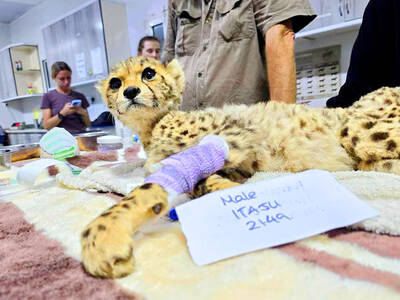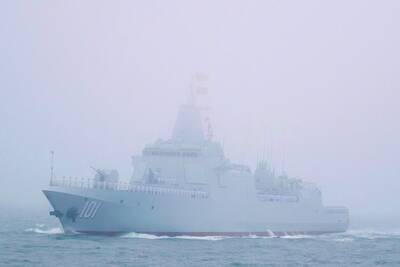The Inner Mongolian Autonomous Region in China has approved a massive power project that would use solar and wind to produce green hydrogen.
The Inner Mongolian Energy Administration has given the go ahead to a cluster of plants in the cities of Ordos and Baotou that would use 1.85 gigawatts (GW) of solar and 370 megawatts (MW) of wind to produce 60,691 tonnes of green hydrogen a year, the Hydrogen Energy Industry Promotion Association said in a report.
Development is scheduled to begin in October and the projects would be operational in mid-2023, the association said, without specifying the cost or the developers.
The project, which would produce enough hydrogen output to displace about 681.37 million liters of gasoline a year if it were used for fuel-cell vehicles, is the biggest yet to be spearheaded by the Chinese government, BloombergNEF analyst Wang Xiaoting (王瀟婷) said.
China’s booming hydrogen industry still has bottlenecks — including how the fuel is stored and used — which need to be tackled in the next five years, Securities Daily said in an article yesterday.
Less than 20 percent of the power from the Inner Mongolian development would go to the grid, with the rest dedicated to green hydrogen.
While several projects have been announced in China that combine renewables with green hydrogen, most are intended for electricity generation first, with the hydrogen component just window dressing to help get approval, Wang said.
However, the project would require at least 465MW of electrolyzers to produce that much hydrogen, she said, adding that global electrolyzer shipments were just 200MW last year and are forecast to be 400MW this year.
“These projects will install more electrolyzers than the entire global market in 2021,” Wang said.
Hydrogen is widely viewed as vital to China’s drive to decarbonize its economy by 2060.
The output value of the country’s hydrogen industry is forecast at 1 trillion yuan (US$154.3 billion) in five years’ time and could reach 12 times that by 2050, Bloomberg Intelligence has said, citing China Hydrogen Alliance projections.
The biggest Chinese green hydrogen projects have so far come from industrial giants such as Sinopec or Ningxia Baofeng Energy Group, which is set to complete a 150MW solar-powered electrolyzer array this year at one of its coal-to-chemical plants.
China Baowu Steel Group has announced plans for 1.5GW of renewable-powered electrolyzers, without providing timing.
While Inner Mongolia has long been one of the leading coal mining regions in China, officials are positioning it as a potential renewable energy hub to distribute electricity and hydrogen to the rest of the country.
The region receives about 3,100 hours of sunlight a year for solar generation, and is located on the main channel of Siberian wind that could power dozens of gigawatts of wind turbines, the association said.

ELECTION DISTRACTION? When attention shifted away from the fight against the militants to politics, losses and setbacks in the battlefield increased, an analyst said Recent clashes in Somalia’s semi-autonomous Jubaland region are alarming experts, exposing cracks in the country’s federal system and creating an opening for militant group al-Shabaab to gain ground. Following years of conflict, Somalia is a loose federation of five semi-autonomous member states — Puntland, Jubaland, Galmudug, Hirshabelle and South West — that maintain often fractious relations with the central government in the capital, Mogadishu. However, ahead of elections next year, Somalia has sought to assert control over its member states, which security analysts said has created gaps for al-Shabaab infiltration. Last week, two Somalian soldiers were killed in clashes between pro-government forces and

Ten cheetah cubs held in captivity since birth and destined for international wildlife trade markets have been rescued in Somaliland, a breakaway region of Somalia. They were all in stable condition despite all of them having been undernourished and limping due to being tied in captivity for months, said Laurie Marker, founder of the Cheetah Conservation Fund, which is caring for the cubs. One eight-month-old cub was unable to walk after been tied up for six months, while a five-month-old was “very malnourished [a bag of bones], with sores all over her body and full of botfly maggots which are under the

BRUSHED OFF: An ambassador to Australia previously said that Beijing does not see a reason to apologize for its naval exercises and military maneuvers in international areas China set off alarm bells in New Zealand when it dispatched powerful warships on unprecedented missions in the South Pacific without explanation, military documents showed. Beijing has spent years expanding its reach in the southern Pacific Ocean, courting island nations with new hospitals, freshly paved roads and generous offers of climate aid. However, these diplomatic efforts have increasingly been accompanied by more overt displays of military power. Three Chinese warships sailed the Tasman Sea between Australia and New Zealand in February, the first time such a task group had been sighted in those waters. “We have never seen vessels with this capability

‘NO INTEGRITY’: The chief judge expressed concern over how the sentence would be perceived given that military detention is believed to be easier than civilian prison A military court yesterday sentenced a New Zealand soldier to two years’ detention for attempting to spy for a foreign power. The soldier, whose name has been suppressed, admitted to attempted espionage, accessing a computer system for a dishonest purpose and knowingly possessing an objectionable publication. He was ordered into military detention at Burnham Military Camp near Christchurch and would be dismissed from the New Zealand Defence Force at the end of his sentence. His admission and its acceptance by the court marked the first spying conviction in New Zealand’s history. The soldier would be paid at half his previous rate until his dismissal